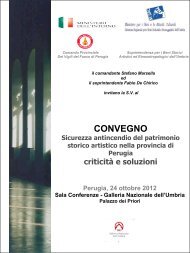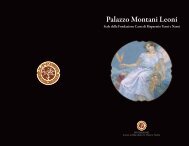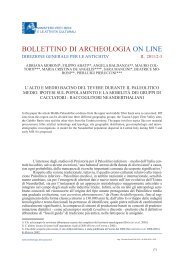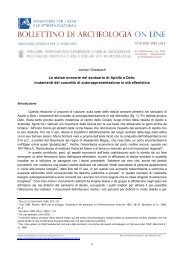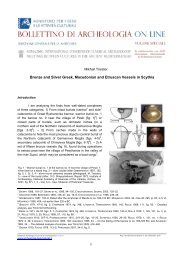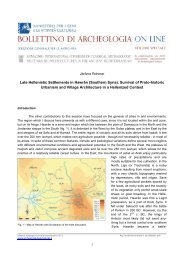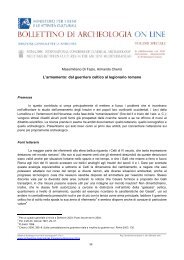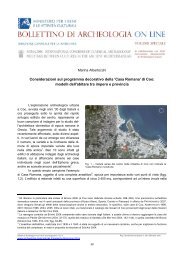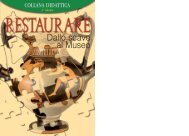The Northern Origin of the Melon Coiffure in Classical Greece
The Northern Origin of the Melon Coiffure in Classical Greece
The Northern Origin of the Melon Coiffure in Classical Greece
Create successful ePaper yourself
Turn your PDF publications into a flip-book with our unique Google optimized e-Paper software.
Ersilia Lopes<br />
<strong>The</strong> <strong>Nor<strong>the</strong>rn</strong> <strong>Orig<strong>in</strong></strong> <strong>of</strong> <strong>the</strong> <strong>Melon</strong> <strong>Coiffure</strong> <strong>in</strong> <strong>Classical</strong> <strong>Greece</strong><br />
Analysis <strong>of</strong> <strong>the</strong> sources for this type <strong>of</strong> coiffure<br />
Our start<strong>in</strong>g po<strong>in</strong>t for <strong>the</strong> research is Euripides’ Iphigenia <strong>in</strong> Tauris (v. 1140-1151), where <strong>the</strong><br />
priestess <strong>of</strong> Artemis <strong>in</strong> Tauris recalls her service to Artemis as a virg<strong>in</strong>. Her tra<strong>in</strong><strong>in</strong>g <strong>in</strong>cluded <strong>in</strong>struction <strong>in</strong><br />
danc<strong>in</strong>g, as gracious movement and attractive coiffure are a requirement for serv<strong>in</strong>g <strong>the</strong> goddess.<br />
Woman’s hair is an essential component <strong>of</strong> <strong>the</strong> married life <strong>of</strong> young brides, whose charis <strong>the</strong>y use to<br />
charm <strong>the</strong>irs husbands. In <strong>the</strong> expression spoken by <strong>the</strong> priestess rich coiffures (ἁβρόπλουτον χαíτας), <strong>the</strong><br />
adjective ἁβρόπλουτος is composed <strong>of</strong> ἁβρός, “pretty”, “s<strong>of</strong>t”, and πλούτος, “rich”, “luxuriant”. <strong>The</strong> term<br />
χαίτας is used to describe long, abundant hair. <strong>The</strong> term χαíτας <strong>in</strong>dicates long, abundant hair and<br />
corresponds to <strong>the</strong> Avestic “gaēsa”, curly hair 1 . <strong>The</strong> dramatist thus uses an archaic and unusual word that<br />
spr<strong>in</strong>gs from a deeply rooted collective religious idea.<br />
Accord<strong>in</strong>g to Hesych, s.v. Koureotis, young girls cut <strong>of</strong>f <strong>the</strong>ir locks, <strong>of</strong>fer<strong>in</strong>g <strong>the</strong>m to Artemis dur<strong>in</strong>g<br />
<strong>the</strong> month <strong>of</strong> Pianepsion (second fortnight <strong>of</strong> October/ first fortnight <strong>of</strong> November) 2 .<br />
Hairstyle was extremely important <strong>in</strong> rites and ceremonies <strong>in</strong> honour <strong>of</strong> Artemis, as can be seen from<br />
Herodotus, who stresses <strong>the</strong> importance <strong>of</strong> <strong>the</strong> Delians and Hyperboreans (4.33.24-25). Heralds brought<br />
<strong>of</strong>fer<strong>in</strong>gs wrapped <strong>in</strong> straw from distant nor<strong>the</strong>rn populations <strong>in</strong> Delos. A rite <strong>in</strong> honour <strong>of</strong> maidens who had<br />
disappeared was performed, with <strong>the</strong> maiden be<strong>in</strong>g evoked by means <strong>of</strong> <strong>the</strong> locks <strong>of</strong> hair. <strong>The</strong> <strong>of</strong>fer<strong>in</strong>g <strong>of</strong> hair<br />
<strong>in</strong> this case marks <strong>the</strong> upper limit <strong>of</strong> childhood. <strong>The</strong> custom <strong>of</strong> Scythians and Thracians was similar and this<br />
similarity also extended to <strong>the</strong>ir coiffures. Herodotus goes on to relate that <strong>the</strong> rite <strong>in</strong>cludes <strong>the</strong> cutt<strong>in</strong>g <strong>of</strong> <strong>the</strong><br />
hair.<br />
As to <strong>the</strong> accuracy <strong>of</strong> Herodotus’ <strong>in</strong>formation, evidence <strong>of</strong> his reliability can be found <strong>in</strong> his<br />
presentation <strong>of</strong> <strong>the</strong> legend <strong>of</strong> Orion, killed because he challenged Artemis to discus throw<strong>in</strong>g.<br />
Moreover, <strong>the</strong> myth that Orion attempted to rape Ope, one <strong>of</strong> <strong>the</strong> Hyperborean virg<strong>in</strong>s, and that<br />
Artemis killed <strong>the</strong> hunter with one <strong>of</strong> her arrows (Apollodorus, Biblio<strong>the</strong>ca, 1.16) also <strong>in</strong>dicates <strong>the</strong> particular<br />
devotion <strong>of</strong> this nor<strong>the</strong>rn population to Artemis and <strong>the</strong> importance <strong>of</strong> <strong>the</strong> virg<strong>in</strong>al status <strong>of</strong> girls who served<br />
her. We f<strong>in</strong>d references to <strong>the</strong> nuptial bath and <strong>the</strong> cutt<strong>in</strong>g <strong>of</strong> <strong>the</strong> lock <strong>in</strong> Iphigenia <strong>in</strong> Tauris (v.818-821).<strong>The</strong><br />
maiden is brought to <strong>the</strong> altar <strong>of</strong> sacrifice by means <strong>of</strong> deceit for her betrothal to Achilles.<br />
Whilst <strong>the</strong> most important aspect <strong>of</strong> sacrifice is to dedicate to <strong>the</strong> gods <strong>the</strong> most beautiful th<strong>in</strong>g that<br />
one possesses, <strong>the</strong> first fruit, preparation for <strong>the</strong> rite that accompanies <strong>the</strong> sacrifice deprives <strong>the</strong> woman <strong>of</strong><br />
1 LIDDEL and SCOTT 1996, 1423.<br />
2 DEUBNER 1932; latest 1956, 234, 1.<br />
Bollett<strong>in</strong>o di Archeologia on l<strong>in</strong>e I 2010/ Volume speciale/ Poster Session 7 Reg. Tribunale Roma 05.08.2010 n. 330 ISSN 2039 - 0076<br />
www.archeologia.beniculturali.it/pages/pubblicazioni.html<br />
97
E. Lopes – <strong>The</strong> <strong>Nor<strong>the</strong>rn</strong> <strong>Orig<strong>in</strong></strong> <strong>of</strong> <strong>the</strong> <strong>Melon</strong> <strong>Coiffure</strong> <strong>in</strong> <strong>Classical</strong> <strong>Greece</strong><br />
<strong>the</strong> right and <strong>of</strong> <strong>the</strong> name <strong>of</strong> par<strong>the</strong>nos, accord<strong>in</strong>g to a passage <strong>of</strong> Par<strong>the</strong>nius, transmitted by Asclepiades <strong>of</strong><br />
Mirlea (FGrHist 697 F1). <strong>The</strong> girl’s m<strong>in</strong>d must be free from any typically female thoughts, because <strong>the</strong><br />
<strong>of</strong>fer<strong>in</strong>g must be pure.<br />
A primitive belief survives <strong>in</strong> this conception: Artemis is <strong>the</strong> god <strong>of</strong> <strong>the</strong> wilderness <strong>of</strong> a world, <strong>of</strong> a<br />
world which does not abide by <strong>the</strong> normal customs <strong>of</strong> human society. For this reason, <strong>the</strong> goddess’ ideal<br />
habitat is woodland. Although she is still a potnia <strong>the</strong>ron, “lady <strong>of</strong> animals”, <strong>the</strong> goddess takes on a new<br />
mean<strong>in</strong>g <strong>in</strong> <strong>the</strong> heart <strong>of</strong> <strong>the</strong> polis. She symbolizes uncontam<strong>in</strong>ated purity, typical <strong>of</strong> a nature not subdued by<br />
mank<strong>in</strong>d, and this sacred human value for <strong>the</strong> Greeks is projected onto <strong>the</strong> chastity <strong>of</strong> <strong>the</strong> goddess: “virg<strong>in</strong>s<br />
are under <strong>the</strong> special protection <strong>of</strong> <strong>the</strong> goddess before adolescence”. Thus <strong>the</strong>y are free from any sexual<br />
contam<strong>in</strong>ation, as demanded by <strong>the</strong> needs <strong>in</strong>volved <strong>in</strong> adapt<strong>in</strong>g society 3 .<br />
Interest<strong>in</strong>gly, a description <strong>in</strong> <strong>the</strong> Onomasticon by Pollux 2. 28 suggests that this hair style was well<br />
known <strong>in</strong> <strong>the</strong> V c. BC and its floruit should be dated to <strong>the</strong> IV c. BC. Pherecrates (frg. 259 K. – A.) def<strong>in</strong>es<br />
female locks as “plaited”. Comedy certa<strong>in</strong>ly refers to ‘storthyngas’, <strong>the</strong> hair which is held twisted up by <strong>the</strong><br />
dirty tags; and <strong>the</strong> Euboians were said that <strong>the</strong> wear long hair beh<strong>in</strong>d; by contrast <strong>the</strong> Thracians wear raised<br />
hair 4 .<br />
This passage also reviews <strong>the</strong> hair styles <strong>of</strong> <strong>the</strong> Aegean populations and establishes an important<br />
l<strong>in</strong>k between <strong>the</strong> coiffures <strong>of</strong> Attica, Euboia and Thrace.<br />
<strong>The</strong> appeal <strong>of</strong> <strong>the</strong> barbarians: <strong>the</strong> melon coiffure from nor<strong>the</strong>rn lands to A<strong>the</strong>ns<br />
It was hi<strong>the</strong>rto believed that a stater from Orthagoria<br />
(fig. 1), on <strong>the</strong> Aegean coast <strong>of</strong> Thrace, a co<strong>in</strong> type dat<strong>in</strong>g<br />
around 350, displays one <strong>of</strong> <strong>the</strong> first examples <strong>of</strong> <strong>the</strong> melon<br />
coiffure”. Delete <strong>the</strong> sentence “this co<strong>in</strong> type dates around<br />
350) 5 .<br />
<strong>The</strong> <strong>in</strong>clusion <strong>of</strong> this north Aegean city with<strong>in</strong> <strong>the</strong><br />
hegemonic state <strong>of</strong> <strong>the</strong> time, Macedony, suggests that this<br />
typology <strong>of</strong> Artemis became <strong>in</strong>fluential, encourag<strong>in</strong>g <strong>the</strong> depiction<br />
<strong>of</strong> this type <strong>of</strong> coiffure <strong>in</strong> o<strong>the</strong>r representations <strong>of</strong><br />
Artemis, even <strong>in</strong> <strong>the</strong> most creative areas <strong>of</strong> <strong>the</strong> Greek society.<br />
Ano<strong>the</strong>r co<strong>in</strong> from Orthagoria, a hemidrachm (fig. 2), is<br />
extremely important, s<strong>in</strong>ce it depicts Artemis: her nose is<br />
straight, her forehead high and her ch<strong>in</strong> even 6 . She looks<br />
ahead. Her closed lips <strong>in</strong>dicate concentration and pride. An<br />
earr<strong>in</strong>g with a triple pendent adorns her pr<strong>of</strong>ile. Her necklace<br />
consists <strong>of</strong> globelets. <strong>The</strong> top <strong>of</strong> her quiver has scotia and a<br />
dome-like lid with a globular end. Her coiffure is rem<strong>in</strong>iscent <strong>of</strong><br />
those <strong>of</strong> <strong>the</strong> so-called Tanagra figur<strong>in</strong>es <strong>of</strong> late <strong>Classical</strong> and<br />
Hellenistic times: such figur<strong>in</strong>es were fashionable at <strong>the</strong> time <strong>of</strong><br />
<strong>the</strong> co<strong>in</strong> (fig. 3) 7 .<br />
Margarete Bieber, and later Gisela Richter, conv<strong>in</strong>c<strong>in</strong>gly<br />
suggested an analogy with <strong>the</strong> coiffure <strong>of</strong> a statuette<br />
3<br />
BRELICh 1985, 59.<br />
4<br />
BETHE 1900, 89.<br />
5<br />
STUART POOLE 1879, 88, nos. 1-5; BABELON 1928, 671, no. 1079, pl. 320, 1; GÄBLEr 1935, 92, pl. XVIII, 21; WAGGONER 1987, 21, no.<br />
562.<br />
6<br />
STUART POOLE 1879, no. 5; BABELON 1928, 671, no. 1080, pl. 320, 2; GÄBLER 1935, 92–93, pl. XVIII, 22; WAGGONER 1987, 21, no.<br />
563.<br />
7 BECQ 2003, 269, no. 210.<br />
Bollett<strong>in</strong>o di Archeologia on l<strong>in</strong>e I 2010/ Volume speciale/ Poster Session 7 Reg. Tribunale Roma 05.08.2010 n. 330 ISSN 2039 - 0076<br />
www.archeologia.beniculturali.it/pages/pubblicazioni.html<br />
98<br />
Fig. 1 - Head <strong>of</strong> Artemis on silver co<strong>in</strong>s struck at<br />
Orthagoria. Stater, from Orthagoria. New York,<br />
American Numismatic Society<br />
(from www.wildw<strong>in</strong>ds.org).<br />
Fig. 2 - Head <strong>of</strong> Artemis on silver co<strong>in</strong>s struck at<br />
Orthagoria. Hemidrachm, from Orthagoria. New<br />
York, American Numismatic Society<br />
(from www.wildw<strong>in</strong>ds.org).
Fig. 3 - Tanagr<strong>in</strong>e, terracotta. Paris, Musée du<br />
Louvre (from PASQUIER and ARAVANTINOS 2003).<br />
Fig. 6 - Muse <strong>of</strong> Mant<strong>in</strong>eia (Arcadia), Pentelic marble. A<strong>the</strong>ns,<br />
National Archaeological Museum.<br />
XVII International Congress <strong>of</strong> <strong>Classical</strong> Archaeology, Roma 22-26 Sept. 2008<br />
Session: Material Culture and Ancient Technology /Cultura Materiale e Tecnologia Antica<br />
Bollett<strong>in</strong>o di Archeologia on l<strong>in</strong>e I 2010/ Volume speciale/ Poster Session 7 Reg. Tribunale Roma 05.08.2010 n. 330 ISSN 2039 - 0076<br />
www.archeologia.beniculturali.it/pages/pubblicazioni.html<br />
99<br />
represent<strong>in</strong>g Cor<strong>in</strong>na by Silanion <strong>in</strong><br />
<strong>the</strong> Musée Anto<strong>in</strong>e Vivenel at Compiègne<br />
(fig. 4) 8 .<br />
<strong>The</strong> s<strong>of</strong>tness <strong>of</strong> <strong>the</strong> flesh on<br />
<strong>the</strong> neck and <strong>the</strong> prom<strong>in</strong>ence <strong>of</strong> <strong>the</strong><br />
lower eyelid are typical features <strong>of</strong><br />
IV th century sculpture.<br />
<strong>The</strong> head identified with<br />
Praxiteles' Artemis Brauronia <strong>in</strong> <strong>the</strong><br />
Acropolis Museum (fig. 5) is very<br />
similar to <strong>the</strong> head on <strong>the</strong> stater from Orthagoria 9 .<br />
<strong>The</strong> close similarities between <strong>the</strong>se two heads<br />
suggests <strong>the</strong> existence <strong>of</strong> a l<strong>in</strong>k between <strong>the</strong> north<br />
Aegean and Attic late upper case.<br />
From <strong>the</strong> historical po<strong>in</strong>t <strong>of</strong> view, <strong>the</strong> relief<br />
slabs from <strong>the</strong> Mant<strong>in</strong>ea base (fig. 6), is <strong>of</strong> importance<br />
here as it is attributed to Praxiteles’<br />
workshop (330 B.C.) by Pausanias (8.9.3) 10 : <strong>the</strong><br />
second Muse on <strong>the</strong> right-hand slab is rem<strong>in</strong>iscent<br />
<strong>of</strong> <strong>the</strong> Small Herculaneum Woman (fig.7) 11 and<br />
wears a coiffure very similar to that <strong>of</strong> <strong>the</strong> Acropolis<br />
Artemis. Accor-d<strong>in</strong>g to <strong>the</strong> passage by Euripides<br />
quoted above, dur<strong>in</strong>g service <strong>in</strong> <strong>the</strong> sanctuary <strong>of</strong> <strong>the</strong><br />
goddess, young girls were required to plait <strong>the</strong>ir hair<br />
as part <strong>of</strong> <strong>the</strong>ir complete transformation <strong>in</strong>to women.<br />
A gold plate (400-375 BC) <strong>in</strong> <strong>the</strong> Hermitage<br />
8 BIEBEr 1955, 44, figs. 120-23; RICHTER 1965, 144, figs. 780-82; ROLLEY 1999, 303; VORSTER 2004, 382–428 esp. 424, fig. 402; SEG<br />
LIV, 2008, no. 509.<br />
9 DESPINIS 1997, 209–17.<br />
10 KALTSAS 2007, 82–87 and DESPINIS 1997, 88–89.<br />
11 DAEHNER ET ALII 2008.<br />
Fig. 4 - Cor<strong>in</strong>na, white<br />
marble (head) and pavonazzetto<br />
(body) by Silanion.<br />
(from R. HUTIN).<br />
Fig. 5 - Artemis Brauronia, Parian marble.<br />
A<strong>the</strong>ns, Acropolis Museum<br />
(photo Ersilia Lopes).
E. Lopes – <strong>The</strong> <strong>Nor<strong>the</strong>rn</strong> <strong>Orig<strong>in</strong></strong> <strong>of</strong> <strong>the</strong> <strong>Melon</strong> <strong>Coiffure</strong> <strong>in</strong> <strong>Classical</strong> <strong>Greece</strong><br />
Fig. 7 - Small Herculaneum Woman, White marble. A<strong>the</strong>ns,<br />
National Archaeological Museum (photo Ersilia Lopes).<br />
Fig. 9 - Bendis rid<strong>in</strong>g a lioness, silver<br />
o<strong>in</strong>ochoe. From Rogozen. Vratsa, Historical<br />
Archaeological Museum (from MARAZOV<br />
1998).<br />
Bollett<strong>in</strong>o di Archeologia on l<strong>in</strong>e I 2010/ Volume speciale/ Poster Session 7 Reg. Tribunale Roma 05.08.2010 n. 330 ISSN 2039 - 0076<br />
www.archeologia.beniculturali.it/pages/pubblicazioni.html<br />
100<br />
Fig. 8 - Scythian warriors on golden plaque. From Kul’Oba.<br />
St. Petersburg, Hermitage Museum (from SCHILTZ 1994a).<br />
Fig. 10 - Female heads. Silver skyphos. From Strelcha.<br />
Sophia, Archaeological Institute and Museum (from MARAZOV<br />
1998).<br />
Museum <strong>in</strong> St. Petersburg provides precious evidence on <strong>the</strong> exchange between Scythians and Thracians.<br />
<strong>The</strong> ornament depicts two Scythian warriors hold<strong>in</strong>g out <strong>the</strong>ir bows (fig. 8) 12 . <strong>The</strong>y wear <strong>the</strong>ir hair divided <strong>in</strong>to<br />
bands form<strong>in</strong>g large masses, ga<strong>the</strong>red <strong>in</strong> impressive chignons. We can thus assume that <strong>the</strong> Thracians, who<br />
wore <strong>the</strong>ir hair <strong>in</strong> a similar manner, transmitted <strong>the</strong> comae comptus to <strong>the</strong> Scythians.<br />
Ano<strong>the</strong>r important piece <strong>of</strong> evidence is vital for our analysis: a o<strong>in</strong>ochoe (350-300 B.C.) from<br />
Rogozen <strong>in</strong> Bulgaria was made by Thracian craftsman and is not strongly <strong>in</strong>fluenced by Greek prototypes<br />
(fig. 9). Ano<strong>the</strong>r vase depicts <strong>the</strong> heads <strong>of</strong> several women, whose coiffure foreshadows <strong>the</strong> “melon coiffure”<br />
(fig. 10) 13 .<br />
12 SCHILTZ 1994a, 185–205, esp. 182–84.<br />
13 TAČEVA 1987, 4, 1–11; EWIGLEBEN 1989, 29–2; BOUZEK and ANDŘEJOVÁ 1990, 81–91; MARAZOV 1996.
Fig. 11 - Hierogamia, gilded silver plaque. From Letnica.<br />
Loveč, Archaeological Museum (from MARAZOV 1998).<br />
A verse from <strong>the</strong> Iliad (4. 533) describes<br />
<strong>the</strong> Thracians as a people with raised hair who<br />
made use <strong>of</strong> long spears, Τρήϊκες ἁκρόκοµοι,<br />
δολίχ’εγχεα χερσίν εÀχοντες.<br />
Ei<strong>the</strong>r Archilochus or Hipponax, echo<strong>in</strong>g<br />
<strong>the</strong> Homeric description, describes <strong>the</strong> Thracians<br />
ακρό[κ]οµοι, “<strong>the</strong> Thracians, hair raised”<br />
(Archilochus, fr. 193 Tarditi = Hipponax, fr. 115<br />
Gerber). This expression may refer ei<strong>the</strong>r to a<br />
chignon or to <strong>the</strong> habit <strong>of</strong> shav<strong>in</strong>g <strong>the</strong> head,<br />
leav<strong>in</strong>g only part <strong>of</strong> <strong>the</strong> hair on top <strong>of</strong> <strong>the</strong> head.<br />
<strong>The</strong> hierogamia on a gold plate from Letnica<br />
(mid <strong>of</strong> IV th century) depicts <strong>the</strong> k<strong>in</strong>g’s high tuft,<br />
as he makes love to a priestess. This union<br />
XVII International Congress <strong>of</strong> <strong>Classical</strong> Archaeology, Roma 22-26 Sept. 2008<br />
Session: Material Culture and Ancient Technology /Cultura Materiale e Tecnologia Antica<br />
would have guaranteed <strong>the</strong> fertility and wealth for <strong>the</strong>ir country (fig. 11) 14 . <strong>The</strong> coiffures <strong>of</strong> <strong>the</strong> Scythians on<br />
an amphora (400-365 B.C.) held <strong>in</strong> Hermitage eloquently testifies to this long and endur<strong>in</strong>g relationship 15 .<br />
Here <strong>the</strong>re is no chignon; <strong>the</strong> hair is loose and <strong>the</strong> organization <strong>of</strong> <strong>the</strong> locks resembles a compressed spiral<br />
<strong>The</strong> breast plate from <strong>the</strong> Kurgan Tolstaja Mogila near Ordžnikidze, which came to light <strong>in</strong> 1971 (mid-IV c.),<br />
shows <strong>the</strong> hairstyle <strong>of</strong> <strong>the</strong> sitter, who should be identified with a Scythian (figs. 12-13) 16 . <strong>The</strong> style is<br />
rem<strong>in</strong>iscent <strong>of</strong> <strong>the</strong> modern “Afro” hair style. A centre part<strong>in</strong>g gives way to lateral <strong>in</strong>terlaced bands term<strong>in</strong>at<strong>in</strong>g<br />
<strong>in</strong> compressed spirals (fig. 14). Interest<strong>in</strong>gly, <strong>the</strong> central part<strong>in</strong>g creates two sections <strong>of</strong> hair, each <strong>of</strong> which is<br />
subdivided <strong>in</strong>to five segments collected <strong>in</strong> a chignon, as <strong>in</strong> <strong>the</strong> case <strong>of</strong> <strong>the</strong> <strong>Melon</strong>enfrisur. <strong>The</strong> difference is<br />
that <strong>the</strong> hair on <strong>the</strong> breast-plate is not ga<strong>the</strong>red at <strong>the</strong> nape.<br />
14 VENEDIKOV and MARASOV 1980, 94, fig. 270.<br />
15 GALANINA and GRATSCH 1986, 265–66.<br />
16 ROLLE 1991, 115–26, figs. 2, 3; REEDER and NIDY 1999, 326–31.<br />
Fig. 12 - Golden breast plate. From Ordžnikidze, Kurgan Tolstaja<br />
Mogila. Museum <strong>of</strong> Kiev, Historical Heritage <strong>of</strong> Ucra<strong>in</strong>a (from<br />
GALANINA and GRATSCH 1986 and REEDEr and NIDY 1999).<br />
Fig. 13 - Golden breast plate. From Ordznikidze, Kurgan Tolstaja<br />
Mogila. St. Petersburg, Hermitage Museum<br />
(VENEDIKOV and MARASOV 1980).<br />
Bollett<strong>in</strong>o di Archeologia on l<strong>in</strong>e I 2010/ Volume speciale/ Poster Session 7 Reg. Tribunale Roma 05.08.2010 n. 330 ISSN 2039 - 0076<br />
www.archeologia.beniculturali.it/pages/pubblicazioni.html<br />
101
E. Lopes – <strong>The</strong> <strong>Nor<strong>the</strong>rn</strong> <strong>Orig<strong>in</strong></strong> <strong>of</strong> <strong>the</strong> <strong>Melon</strong> <strong>Coiffure</strong> <strong>in</strong> <strong>Classical</strong> <strong>Greece</strong><br />
Fig. 14 - A lady wear<strong>in</strong>g <strong>the</strong> melon coiffure. Tranche de vie, 7 th July 2008. Tram <strong>in</strong><br />
A<strong>the</strong>ns, melon coiffure worn by African lady (photo Ersilia Lopes).<br />
Bollett<strong>in</strong>o di Archeologia on l<strong>in</strong>e I 2010/ Volume speciale/ Poster Session 7 Reg. Tribunale Roma 05.08.2010 n. 330 ISSN 2039 - 0076<br />
www.archeologia.beniculturali.it/pages/pubblicazioni.html<br />
102<br />
<strong>The</strong> hair <strong>of</strong> <strong>the</strong> Scythian<br />
warrior depicted on a gold plate<br />
from <strong>the</strong> Kurgan <strong>of</strong> Kul’Oba is held<br />
<strong>in</strong> several layers 17 .<br />
A runn<strong>in</strong>g woman depicted<br />
on an Attic krater (470 B.C.) held<br />
at <strong>the</strong> Antiken Museum <strong>in</strong> Munich<br />
has numerous tattoos on her body.<br />
In Thracian societies this was a<br />
mark <strong>of</strong> high rank (Herodotus, 5, 5,<br />
6-8). <strong>The</strong> woman brandishes <strong>the</strong><br />
sword which will stab Orpheus (fig.<br />
15) 18 . Her hair style is very similar<br />
to that <strong>of</strong> <strong>the</strong> Scythian warrior. <strong>The</strong><br />
hair is carefully combed and<br />
wrapped <strong>in</strong> an impressive chignon.<br />
This coiffure certa<strong>in</strong>ly is <strong>in</strong>telligible<br />
<strong>in</strong> <strong>the</strong> light <strong>of</strong> <strong>the</strong> passage by Pollux<br />
we have looked at.<br />
A mid po<strong>in</strong>t between <strong>the</strong>se<br />
two hairstyles presented on <strong>the</strong><br />
breast plate <strong>of</strong> <strong>the</strong> Kurgan <strong>of</strong><br />
Tolstaja Mogila and that on <strong>the</strong> gold plate <strong>of</strong> Kul’Oba can be found on ano<strong>the</strong>r gold plate, also from Kul’Oba,<br />
depict<strong>in</strong>g a Scythian man with an “Afro” held toge<strong>the</strong>r with a piece <strong>of</strong> lace.<br />
Evidence <strong>of</strong> <strong>the</strong> cont<strong>in</strong>uity <strong>of</strong> <strong>the</strong> melon coiffure <strong>in</strong> Scythian territory can be found <strong>in</strong> <strong>the</strong> mid-Imperial<br />
Roman gold appliqué from Novoselki 19 .<br />
<strong>The</strong> maiden with bow and arrows, Artemis or Bendis, represented on <strong>the</strong> appliqué displays a series<br />
<strong>of</strong> thick plaits and at <strong>the</strong> back typical <strong>of</strong> <strong>the</strong> Scythians. On <strong>the</strong> shoulder <strong>of</strong> <strong>the</strong> o<strong>in</strong>ochoe from Rogozen (350-<br />
300) is a battle between lions and stags, leitmotiv <strong>in</strong> Iranian art <strong>in</strong>spired by animals. Igor Marazov’s structural<br />
analysis demonstrated that <strong>the</strong> goddess symbolizes <strong>the</strong> dualism typical <strong>of</strong> <strong>the</strong> transition <strong>of</strong> state from<br />
childhood to adulthood 20 . <strong>The</strong> goddess <strong>of</strong> <strong>the</strong> hunt represents this transition clearly. This can be argued from<br />
<strong>the</strong> Indo-European epos, <strong>in</strong> which <strong>the</strong> betro<strong>the</strong>d must prevail <strong>in</strong> a shoot<strong>in</strong>g-match. In fact, <strong>the</strong> bow is sexually<br />
allusive, as is confirmed by Ausonius, <strong>the</strong> author <strong>of</strong> Cento Nuptialis 21 .<br />
This vase from Rogozen is <strong>the</strong> only surviv<strong>in</strong>g work from a Thracian workshop largely free <strong>of</strong> Hellenic<br />
<strong>in</strong>fluences. <strong>The</strong> opposite can be seen on <strong>the</strong> rhyton from Panagyriste, on which Artemis wears a braid 22 . <strong>The</strong><br />
rhyton was owned by a member <strong>of</strong> <strong>the</strong> Triballian tribe, which expanded its territory and atta<strong>in</strong>ed a certa<strong>in</strong><br />
degree <strong>of</strong> power 23 until Alexander <strong>the</strong> Great <strong>in</strong> 335 24 . Before Alexander’s conquest <strong>the</strong> Triballians had <strong>the</strong><br />
opportunity to exploit <strong>the</strong> quarries <strong>of</strong> <strong>the</strong>ir region (compris<strong>in</strong>g <strong>the</strong> modern cities <strong>of</strong> Vratsa and Vid<strong>in</strong>). A local<br />
handicraft developed <strong>in</strong>to a dist<strong>in</strong>ctive style, which is both recognizable and orig<strong>in</strong>al 25 .<br />
17<br />
SCHILTZ 1994b, 10.<br />
18<br />
BEAZLEY 1963, 551, no. 9 (7); VENEDIKOV and MARAZOV 1980, 34.<br />
19<br />
BRIDGMAN 2005, 30–45.<br />
20<br />
MARAZOV 1986, 111–29.<br />
21<br />
ADAMS 1981, 199–15.<br />
22<br />
EWIGLEBEN 1989, 29–32.<br />
23<br />
THEODOSSIEV 2000, 93–100.<br />
24<br />
SEIBERT 1971,78; TAČEVA 1987, 1–11; BOUZEK and ANDŘEJOVÁ 1990, 81–91; GEORGIEVA 2005, 1–4, 32–40.<br />
25 DAVIES 1935, 217, 224; QUIRING 1948, 69, A 4, A5, 39.
Fig. 17 - Farewell scene. A<strong>the</strong>ns, Kerameikos Museum<br />
(courtesy: A<strong>the</strong>ns, National Archaeological Museum).<br />
XVII International Congress <strong>of</strong> <strong>Classical</strong> Archaeology, Roma 22-26 Sept. 2008<br />
Session: Material Culture and Ancient Technology /Cultura Materiale e Tecnologia Antica<br />
Bollett<strong>in</strong>o di Archeologia on l<strong>in</strong>e I 2010/ Volume speciale/ Poster Session 7 Reg. Tribunale Roma 05.08.2010 n. 330 ISSN 2039 - 0076<br />
www.archeologia.beniculturali.it/pages/pubblicazioni.html<br />
103<br />
We must now ask how this hairstyle<br />
for Artemis became established <strong>in</strong> cont<strong>in</strong>ental<br />
<strong>Greece</strong>. At Verg<strong>in</strong>a, <strong>in</strong> <strong>the</strong> tomb <strong>of</strong> Persephone,<br />
Demeter displays a melon coiffure<br />
(fig. 16) <strong>in</strong> <strong>the</strong> pa<strong>in</strong>ted frieze traditionally<br />
attributed to Nikomachos 26 . This figure <strong>in</strong>dicates<br />
that <strong>in</strong> Macedonia <strong>Melon</strong>enfrisur<br />
appeared fairly early on.<br />
<strong>The</strong> northward expansion <strong>of</strong> <strong>the</strong><br />
Greek world thus also <strong>in</strong>volved <strong>the</strong> spread<br />
<strong>of</strong> <strong>the</strong> nor<strong>the</strong>rn features <strong>in</strong>to <strong>the</strong> sou<strong>the</strong>rn<br />
Aegean area. <strong>The</strong> close relationship between<br />
<strong>the</strong> Macedonian and Thracian pa<strong>in</strong>t<strong>in</strong>gs<br />
has been noted and <strong>in</strong>cludes style,<br />
iconography colours and <strong>the</strong> way <strong>in</strong> which<br />
<strong>the</strong> shades are created 27 .<br />
An archaiz<strong>in</strong>g Macedonian stele <strong>in</strong><br />
relief shows <strong>the</strong> three Graces. <strong>The</strong>y wear<br />
<strong>the</strong> melon coiffure, thus confirm<strong>in</strong>g that this<br />
hair style was well established <strong>in</strong> <strong>the</strong> region, although <strong>the</strong> relief is ra<strong>the</strong>r late (I c. B.C.).<br />
<strong>The</strong> series <strong>of</strong> co<strong>in</strong>s from Aitolion (Aetolia) is also important, s<strong>in</strong>ce <strong>the</strong>y present <strong>the</strong> pr<strong>of</strong>ile <strong>of</strong> Artemis<br />
(250-225 B.C.). She has a chignon and her coiffure is arranged <strong>in</strong> raised bands 28 . <strong>The</strong>re are late<br />
manifestations <strong>of</strong> this trend too: <strong>the</strong> iconography <strong>of</strong> <strong>The</strong>ssaly is very important, because it shows that <strong>the</strong><br />
fashion was systematically adopted 29 .<br />
26 THOMAS 1989, 219–26; MORENO 2002, 112–23, figs. 246, 247, 249–52; OAKLEY 2004, 139–40; BREKOULAKI 2006, 78–99.<br />
27 BLANCKENHAGEN 1982, 251–58; OGNEVOVA and MARINOVA 1991, 12–25.<br />
28 Auktion 2007, 141, no. 451; 142, no. 453–56.<br />
29 CHRISOSTOMOU 1998, 174–75, 23 a.<br />
Fig. 16 - Demeter. Royal tomb I, Verg<strong>in</strong>a, Tomb <strong>of</strong> Persephone<br />
(from BREKOULAKI 2006).<br />
Fig. 15 - Death <strong>of</strong> Orpheus. Attic crater, Pan Pa<strong>in</strong>ter. From Sicily.<br />
Munich, Antikenmuseum (from VENEDIKOV and MARASOV 1980).
E. Lopes – <strong>The</strong> <strong>Nor<strong>the</strong>rn</strong> <strong>Orig<strong>in</strong></strong> <strong>of</strong> <strong>the</strong> <strong>Melon</strong> <strong>Coiffure</strong> <strong>in</strong> <strong>Classical</strong> <strong>Greece</strong><br />
Fig. 18 - Female hair. Tomis, nor<strong>the</strong>rn necropolis<br />
(after CANARACHE 1967).<br />
Bollett<strong>in</strong>o di Archeologia on l<strong>in</strong>e I 2010/ Volume speciale/ Poster Session 7 Reg. Tribunale Roma 05.08.2010 n. 330 ISSN 2039 - 0076<br />
www.archeologia.beniculturali.it/pages/pubblicazioni.html<br />
104<br />
F<strong>in</strong>ally, <strong>the</strong> melon coiffure is present <strong>in</strong><br />
<strong>the</strong> Attic world <strong>in</strong> Late <strong>Classical</strong> times. I have<br />
already noted that Praxiteles gave his statue <strong>of</strong><br />
Artemis Brauronia and one Muse at Mant<strong>in</strong>ea this<br />
coiffure. In addition, <strong>the</strong>re are several Attic stelai<br />
depict<strong>in</strong>g women with <strong>the</strong> <strong>Melon</strong>enfrisur (fig.<br />
17) 30 .<br />
A bronze mirror (<strong>in</strong>v. n. 14326), held <strong>in</strong><br />
<strong>the</strong> National Museum <strong>of</strong> A<strong>the</strong>ns, dates to <strong>the</strong> first<br />
half <strong>of</strong> III c. B.C. and shows <strong>the</strong> pr<strong>of</strong>ile <strong>of</strong> a young<br />
lady with a melon coiffure 31 .<br />
In a grave dated to <strong>the</strong> III c. A.D., <strong>in</strong><br />
Tomis, <strong>in</strong> <strong>the</strong> nor<strong>the</strong>rn necropolis, <strong>the</strong> brown hair<br />
<strong>of</strong> a young girl was found toge<strong>the</strong>r with jewellery,<br />
pottery and similar objects (fig. 18) 32 . <strong>The</strong> tomb<br />
dates to <strong>the</strong> III century AD. <strong>The</strong> early <strong>in</strong>habitants<br />
<strong>of</strong> <strong>the</strong> region may have dedicated hair as a tribute<br />
to a chthonian goddess, but hair has not been<br />
found elsewhere <strong>in</strong> burial contexts, perhaps because<br />
organic material decays easily. <strong>The</strong><br />
coiffure is divided lengthwise <strong>in</strong>to sections us<strong>in</strong>g<br />
two pieces <strong>of</strong> lace. A plait must have surrounded <strong>the</strong> skull <strong>in</strong> order to give <strong>the</strong> girl a meek and sober<br />
appearance. <strong>The</strong> coiffure may have been similar to that <strong>of</strong> <strong>the</strong> goddess <strong>in</strong> <strong>the</strong> Bucarest Museum: <strong>in</strong> o<strong>the</strong>r<br />
words, a <strong>Melon</strong>enfrisur 33 .<br />
This hair <strong>in</strong> Tomis recalls <strong>the</strong> ritual <strong>of</strong>fer<strong>in</strong>g <strong>of</strong> <strong>the</strong> locks <strong>of</strong> hair. Many centuries later, Alexander Pope<br />
stressed <strong>the</strong> moment <strong>of</strong> <strong>the</strong> cutt<strong>in</strong>g <strong>of</strong> <strong>the</strong> hair <strong>in</strong> his mock-heroic poem: “<strong>The</strong> meet<strong>in</strong>g po<strong>in</strong>ts <strong>the</strong> sacred hairs<br />
dissever / From <strong>the</strong> fair head, for ever and for ever!” 34 .<br />
<strong>The</strong> local m<strong>in</strong>t <strong>of</strong> Orthagoria flourishes before 347 BC, at which po<strong>in</strong>t <strong>the</strong> polis came under<br />
Macedonian rule and <strong>the</strong> local m<strong>in</strong>t was <strong>the</strong>refore closed. This year can be considered <strong>the</strong> term<strong>in</strong>us ante<br />
quem for <strong>the</strong> m<strong>in</strong>t <strong>of</strong> Orthagoria, too, which was <strong>in</strong>volved <strong>in</strong> <strong>the</strong> same political events 35 .<br />
In any case, <strong>the</strong> reception <strong>of</strong> <strong>the</strong> melon coiffure <strong>in</strong> sou<strong>the</strong>rn <strong>Greece</strong>, and <strong>in</strong> A<strong>the</strong>ns <strong>in</strong> particular, was<br />
eased by <strong>the</strong> fashion <strong>of</strong> <strong>the</strong> part <strong>of</strong> <strong>the</strong> artists for endow<strong>in</strong>g young women and goddesses with appeal<strong>in</strong>g<br />
coiffures, already clearly apparent <strong>in</strong> <strong>the</strong> vase pa<strong>in</strong>t<strong>in</strong>g by Meidias 36 . This early evidence reveals that this<br />
social need for seductive hair styles was deeply felt <strong>in</strong> A<strong>the</strong>nian society. This demand is ultimately <strong>the</strong><br />
reason why <strong>the</strong> Thracian hairstyle was so successful.<br />
In conclusion, I believe it is possible that <strong>the</strong> reception <strong>of</strong> <strong>the</strong> <strong>Melon</strong>enfrisur <strong>in</strong> sou<strong>the</strong>rn <strong>Greece</strong> <strong>in</strong><br />
late classical times is due to <strong>the</strong> <strong>in</strong>corporation <strong>of</strong> <strong>the</strong> Thracian region <strong>in</strong>to <strong>the</strong> Aegean ko<strong>in</strong>e, culm<strong>in</strong>at<strong>in</strong>g with<br />
<strong>the</strong> entry <strong>of</strong> this area <strong>in</strong>to <strong>the</strong> most important and powerful state <strong>of</strong> <strong>the</strong> region: Macedonia 37 . Thus, some<br />
aspects <strong>of</strong> <strong>the</strong> life style <strong>of</strong> peripheral regions eventually came to conquer cont<strong>in</strong>ental <strong>Greece</strong>.<br />
30<br />
CLAIRMONT 1993, 802, 2.919; see also BESCHI 2003, 147–154; CLAIRMONT 1993, 233–234, 3.371b; 95, no. 4.420; 1993, 357, no.<br />
3.433; 413, no. 3.471; for a comment on <strong>the</strong> <strong>in</strong>scriptions nos. 3.371b, 3433, 3.471 see respectively: TRAILL 2007, 160, no. 86.4820;<br />
2005, 439–440, no. 78.8980; 1994, 356, no. 210965.<br />
31<br />
ZÜCHNER 1942, 82, KS 129 = SCHWARTMAIER 1997, 67 (1), no. 31, tav. 65, 2.<br />
32<br />
CANARACHE 1967, 40.<br />
33<br />
BORDENACHE 1969, 21–2, no. 17, tav. X, XI, XII D.<br />
34<br />
POPE 1714, vv. 153–55.<br />
35<br />
PETER 1997, 140–43.<br />
36<br />
BURN 1987, 97, no. M1, pl. 22-5a; 97, no. M2 pl. 27-9; 111, no. MM75, pl. 26; 106, no. MM17, pl. 34; 98, no. M7, pls. 35-7; 97, no. M2,<br />
pls. 27-9; 100, no. C1, pls. 39-41.<br />
37<br />
HAMMOND and GRIFFITH 266–67; SCHÖNERT-GEISS 1985, 51–62; YOUROUKOVA 1976, 63–70, tav. 19; DIMITROV 1993, 151–63.
XVII International Congress <strong>of</strong> <strong>Classical</strong> Archaeology, Roma 22-26 Sept. 2008<br />
Session: Material Culture and Ancient Technology /Cultura Materiale e Tecnologia Antica<br />
Aknoledgments<br />
I wish to thank various scholars and friends whose help improved this research <strong>in</strong> different ways: Pr<strong>of</strong>. Nicola Parise,<br />
who supervised this research, my teacher Pr<strong>of</strong>. Paolo Moreno, Università Roma Tre, for his valuable advice, Dr. Antonio<br />
Corso, Numismatica e Antichità classiche, Quaderni Tic<strong>in</strong>esi for his cont<strong>in</strong>ous assistance, Pr<strong>of</strong>. Luigi Beschi, Università<br />
di Firenze, for his trust <strong>in</strong> my skills, and Pr<strong>of</strong>. Petros <strong>The</strong>melis, President <strong>of</strong> <strong>the</strong> Society <strong>of</strong> Messenian Archaeological<br />
Studies, whose irony and amusement <strong>in</strong> suggestions delighted me; Dr. Maria Reho, National Archaeological Museum <strong>of</strong><br />
Sophia.<br />
Besides I wish to thank Pr<strong>of</strong>. Nikolaos Kaltzas, National Archaeological Museum for photo no. 18; for <strong>the</strong> improvement <strong>of</strong><br />
photos I am grateful to Mr. Ioannis Patrikianos (Archaiologiki photographia, Athína) and to Mr. David Scahill, American<br />
School <strong>of</strong> <strong>Classical</strong> Studies at A<strong>the</strong>ns for <strong>the</strong> draw<strong>in</strong>g no. 19.<br />
Bibliography<br />
Bollett<strong>in</strong>o di Archeologia on l<strong>in</strong>e I 2010/ Volume speciale/ Poster Session 7 Reg. Tribunale Roma 05.08.2010 n. 330 ISSN 2039 - 0076<br />
www.archeologia.beniculturali.it/pages/pubblicazioni.html<br />
105<br />
Dr. Ersilia Lopes<br />
Capodistrian University <strong>of</strong> A<strong>the</strong>ns<br />
ADAMS J. N., 1981. Ausonio Cento Nuptialis 101-131. SIFC, 53, 199–215.<br />
Auktion 23, Sammlung BCD, Antike Griechische Münzen: Akarnanien und Aetolien, Donnerstag.18. Oktober.<br />
2007, 10.00 Uhr.<br />
BEAZLEY J. D., 1963. Attic Red-figure Vase-pa<strong>in</strong>ters. Oxford (2nd ed).<br />
BABELON E., 1928. Traité des monnaies grecques et roma<strong>in</strong>es, 2, 4. Paris.<br />
BECQ J., 2003. Jeune Drapée. In A. PASQUIER, V. ARAVANTINOS (eds), Tanagra, My<strong>the</strong> et Archeologie: 269,<br />
no. 210. Paris.<br />
BESCHI L., 2003. La stele funararia attica di Pisa. In D. DAMASKOS (ed), Epithymbion Gerhard Neumann,<br />
Mousio Benaki II. Athína, 147–54.<br />
BETHE E. (ed), 1900. Pollucis Onomasticon. Leipzig.<br />
BIEBER M., 1955. <strong>The</strong> Sculpture <strong>of</strong> <strong>the</strong> Hellenistic Age. New York.<br />
BLANCKENHAGEN P. H., 1982. Pa<strong>in</strong>t<strong>in</strong>g <strong>in</strong> <strong>the</strong> Time <strong>of</strong> Alexander and Later. In B. BARR-SHARRAR, E. N. BORZA<br />
(eds), Studies <strong>in</strong> <strong>the</strong> History <strong>of</strong> Art, 10, Macedonia and <strong>Greece</strong> <strong>in</strong> Late Hellenistic Times, Symposium<br />
Series, I. Wash<strong>in</strong>gton, 251–58.<br />
BORDENACHE G., 1969. Sculture greche e romane del Museo Nazionale di Antichità di Bucarest. Bucarest.<br />
BOUZEK J., ANDŘEJOVÁ I., 1990. <strong>The</strong> Rogozen Treasure and <strong>the</strong> Art <strong>of</strong> <strong>the</strong> Triballoi. Eirene, 27, 81–91.<br />
BREKOULAKI H., 2006. La pe<strong>in</strong>ture funeraire de macedo<strong>in</strong>e, Emplois et fonctions de la coleur IVe-II s. av. J.-<br />
C. Athènes, Paris.<br />
BRIDGMAN T. P., 2005. Hyperboreans Myth and History <strong>in</strong> Celtic-Hellenic Contacts. London, New York.<br />
BURN L., 1987. <strong>The</strong> Meidias Pa<strong>in</strong>ter. Oxford.<br />
CANARACHE V., 1967. Le Musée d’archéologie Constantza. Costantza.<br />
CHRYSOSTOMOU P., 1998. E <strong>The</strong>ssalike <strong>The</strong>a En(n)odia e Pheraia <strong>The</strong>a. Athína.<br />
CLAIRMONT C. W., 1993. <strong>Classical</strong> Attic Tombstones, II. Akanthus, Kilchberg.<br />
Courtesy: A<strong>the</strong>ns, National Archaeological Museum.<br />
DAEHNER J., KNOLL K., VORSTER CH., WOELK M., 2008. <strong>The</strong> Herculaneum Women. Los Angeles, Dresden.<br />
DAVIES O., 1935. Roman M<strong>in</strong>es <strong>in</strong> Europe. Oxford.<br />
DESPINIS G., 1997. Zum A<strong>the</strong>ner Brauronion. In W. HOEPFNER (ed), Kult und Kultbauten auf der Akropolis,<br />
Internationales Symposium vom 7. bis 9. Juli 1995 <strong>in</strong> Berl<strong>in</strong>. Berl<strong>in</strong>, 209–217.<br />
DEUBNER L., 1932; latest 1955. Attische Feste. Hildesheim
E. Lopes – <strong>The</strong> <strong>Nor<strong>the</strong>rn</strong> <strong>Orig<strong>in</strong></strong> <strong>of</strong> <strong>the</strong> <strong>Melon</strong> <strong>Coiffure</strong> <strong>in</strong> <strong>Classical</strong> <strong>Greece</strong><br />
DIMITROV K., 1993. Le monnayage et l’idéologie royale en Thrace préhellénistique (f<strong>in</strong> du VIe –premiere<br />
moitié du IVe siècle av. J.C.). In T. HACKENS (ed), Actes du XIe Congrès International de<br />
Numismatique, Bruxelles 8-13 september 1991, 1. Louva<strong>in</strong>, 151–163.<br />
EWIGLEBEN C., 1989. An Atelier <strong>of</strong> Silversmiths <strong>in</strong> Western Thrace: <strong>the</strong> jug cat. no. 155 from Rogozen and its<br />
Connections to <strong>the</strong> Vessels with Figured Reliefs from Poro<strong>in</strong>a, Strelča, Loukovit and Vratsa. In B.<br />
COOK (ed), <strong>The</strong> Rogozen Treasure Papers <strong>of</strong> <strong>the</strong> Anglo-Bulgarian Conference, 12 march 1987.<br />
London, 29–32.<br />
GÄBLER H., 1935. Die antiken Münzen Nord-Griechenlands, III, Die antiken Münzen von Macedonia und<br />
Paionia, 2, Orthagoria. Berl<strong>in</strong>.<br />
GALANINA L., GRATSCH N., 1986. Skythische Kunst. Altertümer der schythischen Welt. Mitte des 7. bis zum 3.<br />
Jahrhundert v. u. Z. Len<strong>in</strong>grad.<br />
GEORGIEVA R., 2005. A small Jug Karnobat with Images <strong>of</strong> Thracian Warriors. Archaeolojia S<strong>of</strong>ia, 46, 1-4,<br />
32–40.<br />
HARTOG F., 1980. Le miroir d’Hérodote. Paris.<br />
KALTSAS N., 2007. Treis anaglyphes plakes apo ependysi vathrou. In N. KALTSAS, G. DESPINIS (eds),<br />
Praxitelis, Catalogue <strong>of</strong> <strong>the</strong> exhibition held <strong>in</strong> <strong>the</strong> National Archaeological Museum <strong>of</strong> A<strong>the</strong>ns, 25 July-<br />
31 October 2007. Athína, 82–87.<br />
LIDDEL H. G., SCOTT R., 1996. A Greek English Lexikon. Oxford.<br />
MARAZOV I., 1986.Thracian Mythology <strong>in</strong> Indo-European context. In <strong>The</strong> Bronze Age <strong>in</strong> <strong>the</strong> Thracian Lands<br />
and Beyond, Fourth International Thracian Conference, Boston 7-10 June 1984. Milan, 111–129.<br />
MARAZOV I., 1996. <strong>The</strong> Rogozen Treasure. S<strong>of</strong>ia.<br />
MARAZOV I. (ed), 1998. <strong>The</strong> Wealth <strong>of</strong> <strong>the</strong> Thracian treasures from <strong>the</strong> republic <strong>of</strong> Bulgaria. New York.<br />
MORENO P., 2002. Il genio differente. Milan.<br />
NIKOLOV B., 1987. Sur le caractère du trésor de Rogozéne. Archaologja S<strong>of</strong>ia 29 (3), 64–66.<br />
NIKOLOV B., 1989. Le trésor thrace de Rogozène, départment de Vratsa, Bulgaria. Thraco-Dacica, 10, 189–<br />
96.<br />
OAKLEY J. H., 2004. Nikomachos (I). In R. VOLLKOMMER (ed), Künsterlexikon der Antike, 2. München, Leipzig,<br />
139–140.<br />
OGNEVOVA L., MARINOVA L., 1991. Kazanlaskata grobnice. Sbornik Trakijskata kultura prezel<strong>in</strong>ističeskata<br />
epoche v Kazanlăškija Kraj, 12–25.<br />
PASQUIER A., ARAVANTINOS V. (eds), 2003. Tanagra, My<strong>the</strong> et Archeologie. Paris.<br />
PETER U., 1997. Die Münzen Thrakischer Dynasten (5.-3. Jahrhundert v. Chr.). Berl<strong>in</strong>.<br />
POPE A., 1714. <strong>The</strong> Rape <strong>of</strong> Lock. London.<br />
QUIRING H., 1948. Geschichte des Goldes. Die Goldenen Zeitalter <strong>in</strong> ihrer kulturellen und wirtschaftlichen<br />
Bedeutung. Stuttgart.<br />
REEDER E. D., NIDY E. (eds), 1999. Scythian Gold, Treasures from Ancient Ukra<strong>in</strong>e, <strong>The</strong> Wolters Art Gallery.<br />
Baltimore. New York.<br />
RICHTER G. M. A., 1965. <strong>The</strong> Portraits <strong>of</strong> <strong>the</strong> Greeks I-III. London.<br />
ROLLE R., 1999. Haar-und Barttracht der Sky<strong>the</strong>n. In R. ROLLE, M. MÜLLER-WILLE, K. SCHIETZEL (eds), Gold<br />
der Steppe, Archäologie der Ucra<strong>in</strong>e. Schleswig 1991. Neumünster.<br />
ROLLEY C., 1999. La sculpture grecque, 2. Paris.<br />
SCHILTZ V., 1994a. Die Sky<strong>the</strong>n und andere Steppenvölker 8. Jahrhundert v. Chr. bis 1. Jahrhundert n. Chr.<br />
München.<br />
SCHILTZ V., 1994b. V<strong>in</strong>gts ans après. Dossier d’archéologie, 20.<br />
SCHÖNERT-GEISS E., 1985. Maroneia und die Thraker: Wechselbeziechungen zwischen Polis und H<strong>in</strong>terland.<br />
Eirene, 22, 51–62.<br />
SCHWARTMAIER A., 1997. Griechische Klappspiegel. JDAI, AM, 18.<br />
SEIBERT J., 1971. Alexander der Grosse. Darmstadt.<br />
SIMON E., 1981. Die Griechischen Vasen. München.<br />
Bollett<strong>in</strong>o di Archeologia on l<strong>in</strong>e I 2010/ Volume speciale/ Poster Session 7 Reg. Tribunale Roma 05.08.2010 n. 330 ISSN 2039 - 0076<br />
www.archeologia.beniculturali.it/pages/pubblicazioni.html<br />
106
XVII International Congress <strong>of</strong> <strong>Classical</strong> Archaeology, Roma 22-26 Sept. 2008<br />
Session: Material Culture and Ancient Technology /Cultura Materiale e Tecnologia Antica<br />
STUART POOLE R., 1879. A Catalogue <strong>of</strong> <strong>the</strong> Greek Co<strong>in</strong>s <strong>in</strong> <strong>the</strong> British Museum. Macedonia. London.<br />
TAČEVA M., 1987. Données archéologiques pour la datation du trésor de Rogozen. Archeologija S<strong>of</strong>ia 29 (4),<br />
1–11.<br />
THEODOSSIEV N., 2000. North-Western Thrace from Fifth to First Centuries BC. Oxford.<br />
THOMAS E., 1989. Nikomachos <strong>in</strong> Verg<strong>in</strong>a? AA, 219–226.<br />
TRAILL J. S., 1994. Persons <strong>of</strong> Ancient A<strong>the</strong>ns. III. Toronto.<br />
TRAILL J. S., 2005. Persons <strong>of</strong> Ancient A<strong>the</strong>ns. XVII. Toronto.<br />
TRAILL J. S., 2007. Persons <strong>of</strong> Ancient A<strong>the</strong>ns. XVI. Toronto.<br />
VENEDIKOV I., MARASOV I. (eds), 1980. Gold der Thraker. Hildesheim.<br />
VORSTER C., 2004. Die Porträts des 4. Jahrhunderts v. Chr. In P. C. BOL (ed), Die Geschichte der antiken<br />
Bildhauerkunst, 2. Ma<strong>in</strong>z am Rhe<strong>in</strong>.<br />
YOUROUKOVA I., 1976. Co<strong>in</strong>s <strong>of</strong> <strong>the</strong> Ancient Thracians. Translated by V. Athanassov. Oxford.<br />
WAGGONER N., 1987. Sylloge Nummorum Graecorum, <strong>The</strong> Collection <strong>of</strong> American Numismatic Society,<br />
Macedonia II: Alexander I- Philip II. American Numismatic Society, 7. New York.<br />
ZÜCHNER W., 1942. Griechische Klappenspiegel. JDAI, Ergänzungsheft.<br />
Bollett<strong>in</strong>o di Archeologia on l<strong>in</strong>e I 2010/ Volume speciale/ Poster Session 7 Reg. Tribunale Roma 05.08.2010 n. 330 ISSN 2039 - 0076<br />
www.archeologia.beniculturali.it/pages/pubblicazioni.html<br />
107



